by Marcela M. | Jul 19, 2011 | Blog, cookies, Recipe Box, Recipes, Sweets, Uncategorized

Good morning dear friends! How are you today? I hope you had a fantastic weekend.
I had planned to write this post before but, as you may know, there was an explosion in a munition deposit in Cyprus, that resulted in the destruction of the island’s main power plant. As a consequence of this, and considering that we are in the middle of a torrid summer, power rationing measures have been put in place (no AC, among others), and we are experiencing daily (sometimes twice daily) power cuts. So I guess the macarons that are the object of this post will be the last baking I will be doing for a while – at least until the situation regularizes a little bit- and I will have to reduce my blog posting to one post per week (on Mondays).
I had wanted to make macarons for a long time but, I must confess, I was terrified by the little cookie. I am not a professional baker and macarons are, as a friend put it, the royalty of baking, so I wondered whether I was going to be up to the task. I read countless recipes and instructions on the internet, and there always seemed to be so many steps that one needed to attend to with extreme care and attention, so many things that could go wrong, so many chances that for some unexplainable equation things would in fact go wrong, that I wondered whether making macarons was reserved for some elite of extremely apt bakers while me, a mere muggle of the craft, could never aspire to having these cute and delicious cookies coming out of my oven.
My favorite recipe was the one Linda (from fabulous blog Call me cupcake) shared on Cake Journal. After I read it, I started thinking that maybe I should try. The instructions were detailed, there were plenty of pictures and the commenters kept mentioning how they had been able to make macarons with it. I was encouraged! I bookmarked the recipe and, for several months, I would go back to it every now and then, not daring to actually try it.
It wasn’t until I read the article “Macaron Mythbusters” in Brave Tart that I actually started thinking “I can do this!” If you haven’t read it, please go now, you can continue reading my post later. I just love the humour with which it is written and, being the nerd that I am, its scientific approach to macaron making fascinates me. When I read that “We’re talking about a cookie here, not the Heisenberg uncertainty principle.” I started laughing hard at myself for having been scared of, yes, a cookie and I decided it was time to give macarons a try. The worst thing that could happen, after all, was wasting a few egg whites, almond powder and sugar…and I could always turn a failure into a different kind of success (as I did here). And if I was going to give them a try, what day could possibly be better than July 14th, Bastille day? I am a Francophile, after all 😉
Stella‘s recipe, though, calls for a very stiff and dry meringue, which I was not sure I could achieve with my Moulinex food processor’s whisk attachment (see photos in this post) . Since one of Stella’s Ten Commandments of Macaron making recommends making meringue as instructed by each recipe, I decided to try Linda‘s recipe first (which calls for a stiff meringue, but not necessarily that stiff), while following Stella’s commandments at the same time. I also tested each step according to both their tips, and contrasted textures with Linda’s pictures and with these ones as well. And I am happy to report that it worked! I still have to work on my piping technique, I have to get to know my oven better (I have now bought an oven thermometer for that purpose, yay!) and I have to work on colouring too, but at least I can happily say that my macarons looked like macarons and-most importantly-tasted like macarons!
In case you are interested in giving them a try- and I encourage you to do so, because they delicious!- here is what I did, with pictures to show you every step :
1- I bought ground almonds but, as both Linda and Stella recommend grinding them even more, this is the first thing I did. I put 200 grams of ground almonds (the whole pack) in my food processor and pulsed 5 times.

2- I sifted the processed almonds (with a colander, as I don’t own a baking sifter) and this is what I ended up with:

3- Using a kitchen scale, I measured 100 grs of ground almonds (what the recipe requires) and saved the rest for some other time in an airtight container. I put the measured almonds in the food processor again, and measured (also with the scale) the required amount of powdered sugar. I added it to the almonds and processed everything for 1 minute. This allows for them to be properly mixed together, and also to break any big lumps there may be (which is necessary for good macarons).

4- I then sifted the dry ingredients twice, and set them aside.
Now it was time to make the meringue! Stella explains that a good macaron requires a stiff meringue so that, once the dry ingredients are added to it, they will have time to be incorporated without the meringue deflating too fast and therefore losing the necessary consistency for macarons to keep their shape. If the meringue is not stiff enough, there is a risk of overmixing the macarons. It is for this same reason that she recommends adding food colouring while making the meringue and not when adding the dry ingredients: this guarantees that the colour will be fully incorporated without compromising the batter’s consistency. So this is what I did.
According to Stella’s mythbusters article, there is no need to age the egg whites for making a good macaron. Linda, however, recommends aging them for 24 hs and, since I was following the latter’s recipe, I did (in case you don’t know what aging an egg white means, I should clarify that what is required is for you to separate the egg whites, to keep them covered with a paper towel in the fridge for 24 hours, and to take them out of the fridge a few hours before using them. You can also keep them at room temperature, if your weather conditions so permit without them getting spoiled).
5- I washed my food processor and made sure that there was no grease in it by cleaning it with a little bit of lemon juice and a paper towel. I then added my aged egg whites and started beating at medium speed.

6- When the egg whites started foaming, I added the ground sugar, one tablespoon at a time.

7- Linda’s recipe asks for a glossy and stiff meringue that won’t slide from the bowl if we put it upside down. I tested the consistency with a spatula (as you can see from the picture below, it doesn’t move)

8- I added gel food colouring with a toothpick, and I continued beating for 2 more minutes, until all colour was evenly incorporated. I was looking for a soft shade of pink – I will have to add less the next time!

9- To my surprise, I ended with a stiffer meringue than I expected (yay! Go, Moulinex, go!). This is what it looked like when I put it into the mixing bowl:

10- I added the dry ingredients all at once, and started folding using a spatula. This is called macaronage, and most recipes I have read mention that it takes around 40 strokes to achieve appropriate macaron consistency. They all agree too in that a slightly under-mixed batter is better that an over-mixed one, so I made sure that I tested the consistency every 3 strokes to make sure I did not over do it. Stella recommends making sure that one scrapes the bowl from all sides several times , so I did this too (see the reasons for this here). I counted the strokes and it took me 44 (ah OCD ;))

11-I tested whether the batter had reached appropriate consistency by checking whether the mixture flowed like a ribbon when holding the spatula over the bowl (as Linda recommends, and as seen below). I also used Stella’s method of spooning some batter out and putting it back into the mix and checking whether it incorporates into it within a few seconds.

12- I filled my pastry bag with the help of a tall glass and started piping the macarons on a baking sheet covered with baking paper.

Now, this is where I made the mistake of piping them too close to each other because I had no idea how much they were going to spread. So, bear in mind that they do spread a bit and that , even if they look nothing like beautiful circles at first, they will look better once they finish spreading (just a few minutes). So give them some room to get a nice round shape, so that once they are in the oven they can grow nicely and so that you don’t have to separate them with a knife once cooked (ouch!). Also, try making them about the same size because you will have to pair them afterwards!
The second sheet I piped turned out better than this one, but I am adding the picture of the first one so that you can learn from my mistakes and see what NOT to do:

13- I tapped the baking sheet against the counter (as Stella recommends) and then let them sit for 2 hours (as Linda’s recipe requires). This was easy to do because we had a power cut just then and I couldn’t put them in the oven immediately even if I wanted to 😉
When the power came back, I turned my oven to 150 degrees celsius (or so I thought) and put the first sheet inside. I said “so I thought” because it took me much longer to cook the macarons than the recipe called for. This could also have been because of the addition of food colouring but, in order to be sure the next time, I have now bought an oven thermometer and I am planning to calibrate my oven before making them again.

In order to know whether they are ready or not, try separating them from the baking sheet. If when you try to take one, the top comes off and the bottom remains attached to the sheet…well, they are not ready. Also, their interior should not be gooey.
This is what they looked like when I took them out of the oven, while they were cooling down.

14- After they cooled down completely, I assembled them. I must confess I used what I had in the fridge as a filling: home made dulce de leche and chocolate ganache. I let them rippen for 24 hours in an airtight container in the fridge before eating them (except for one, for testing purposes and for the sake of science only ;)). They do taste much better after 24 hours, so don’t eat them right away (not all of them at least!)

Now that I have made them once, I can’t wait to make them again and to experiment with new flavours and colours!
Would you like to make them?
Have a nice week and see you again next Monday!
by Marcela M. | Jul 5, 2011 | Blog, cookies, Crafts and DIY, Recipe Box, Recipes, South America, Sweets, Travel, Uncategorized
Good morning friends!
How was your weekend? I hope you had a great time!
July is a month full of celebrations in my home country, Argentina, and it all starts during the first week of the month: From 1st until 7th of July, Argentina celebrates “Sweetness week”. During this week, argentinians exchange a sweet (chocolate, candy, etc) for a kiss.
The tradition originated as part of a promotion campaign to increase the sale of sweets, especially of ARCOR’s bon-o-bon, but it was quickly embraced by the population. Sweetness week is now a time, not only to give away chocolates and candies, but also to be nice to those around us.
Would you like to join in the celebrations, wherever you are?
If you do, Delicious Tea has some adorable free printables that can be printed on sticker paper and attached to individual sweets, or printed on cardboard paper and attached to a gift box. If you would like to use them, all you have to do is “like” their facebook page, “like” their album, leave your email address in the comment below the pictures, and they will send them to you!

If you also want to offer your loved ones some traditionally argentinian home-made sweets, here is my recipe for alfajores de maizena, or conrstarch cookies (which are the ones you can see in the picture at the beginning of this post):
Ingredients:
For the cookies:
800 grs cornstarch
300 grs all-purpose flour
350 grs sugar
3 teaspoons baking powder
4 eggs + 3 egg yolks
1 tablespoon vanilla extract
1/2 kg butter
For the filling:
Dulce de leche
Shredded coconut
Preparation:
1-Mix butter and sugar until creamy.
2- Add eggs, egg yolks and vanilla. Mix well, but not too much- just until all ingredients are incorporated.
3- In a different bowl, mix the dry ingredients.
4- Gradually add the dry ingredients to the butter mixture. Mix thoroughly until you have a workable dough (it should have the texture, more or less, of a pâte sablée)
5- Roll the dough on a floured surface and cut with a round cookie cutter, about 1/2 cm thick.
6- Place on a baking tray covered with baking paper or greased, and put in the oven at 150º C/305 F for about 10 minutes.
Very important: the cookies SHOULD NOT get brown or they will be hard and crumby. Watch them very carefully while they are cooking!
7- Once they are cooked, remove from the oven and let them cool for half an hour.
Assembly:
1- Put shredded coconut in a bowl.
2- Put a layer of dulce de leche on the inside of one cookie, and then place another cookie on top (like a dulce de leche sandwich).
3- Put dulce de leche on the sides of the cookie sandwich with a spatula/knife, and then roll it in shredded coconut (the coconut will then attach to the sides of the cookie).
NOTE: The recipe above is for traditional alfajores de maizena. You can see a picture of wonderfully executed ones, made by Amy,The Sugar Fairy (using this recipe) here. The ones I made for my birthday were coloured to match my dessert table, and filled with buttercream and lemon curd, instead of dulce de leche. This is the beauty of these cookies: they are easy to make and very versatile! If you want to colour the dough, just add a few drops of food colouring at the end of the preparation. This dough can be stored in the freezer.
Have a wonderful Tuesday!
by Marcela M. | Jun 30, 2011 | Blog, cookies, Crafts and DIY, Recipe Box, Recipes, Sweets, Uncategorized

Hello there!
This post was supposed to be published yesterday evening but my internet connection was up and down, so it is only now that I can do it.
I am writing this post because, while cake-pops have been widely popular in the US for quite some time already, they are a novelty in other parts of the world (namely, Cyprus and Argentina!). Consequently, a few readers and friends have asked me after seeing my pictures, what they are and how they are done. And when I have referred them to other websites, they have asked me what candy melts are, whether there are alternatives to them, because they are hard to get, or they do not exist where they live.
Basically, cake-pops are cake, mixed with frosting, covered in chocolate. The procedure for making them is fairly easy: 1- bake a cake 2- let the cake cool for 24 hours 3- crumble the cake 4- Mix with frosting 5- shape the cake-balls 6- attach lollipop stick 7- Dip the cake balls into candy melts/chocolate 8- Add sprinkles or any other decoration. There are also other versions that work with cookies instead of crumbled cake…but technically speaking those would be cookie-pops* 😉
They look simple, right? However, they are not always that simple. In my experience, two things need to be taken into consideration:
1) The mixture of crumbled cake and frosting should not be too moist or the cake-pops will not remain attached to the lollipop stick, they will fall (Argentinian friends: this is why I find that dulce de leche doesn’t work, and that buttercream is better. You may try, but I warned you ;). Therefore, when you start adding frosting after crumbling the cake, it is better to do it little by little and to test consistency. You want to add just enough frosting to be able to shape the balls, not more. After the balls are shaped, keep them in the freezer for 15/20 minutes. If you don’t own a freezer, keep them in the fridge for several hours.
2) The consistency of the candy melts/chocolate is key to achieve a smooth finish. The problem is that candy melts are not always easy to work with, because they harden much faster than regular chocolate. I do not own a microwave, so I melt them in a double boiler and, when they are starting to melt, I take the bowl out of the stove, and start beating the candy melts until they are liquid enough to dip the cake-pops in them. Also, the more candy melts you use the better, because, in order to get a smooth finish, you need to completely submerge the cake-balls in them.
For a very helpful, full of photographs tutorial of Bakerella herself making cake-balls and cake-pops, check these Instructions on how to make cake-pops from The Pioneer Woman’s blog. And check Bakerella’s blog to see and assortment of wonderfully creative ideas on how to make these sweets that drive children crazy at parties!
Two more tips:
1) When I don’t want to make a lot of cake-pops, I bake cupcakes instead of a cake, crumble as many as I need, and freeze the rest. Or I prepare all cake-balls and freeze the ones I don’t need in an airtight container (without dipping them in chocolate).
2) If you cannot find candy melts where you live, you can use chocolate for making truffles or for frosting cakes , which hardens faster (in Spanish: chocolate cobertura). This is necessary for the cake-pops not to drip all chocolate covering down the lollipop stick when you turn them after dipping.
An easy way of decorating the lollipop sticks is with ribbon flags. The ones above are the ones I made for my birthday party and, as you will see, they are really easy.
In order to make them you will need:
1) Ribbon
2) Lollipop sticks
3) glue
4) A pair of scissors
5) self-adhesive scrapbooking gems
6) Tweezers
Here is how to do it:
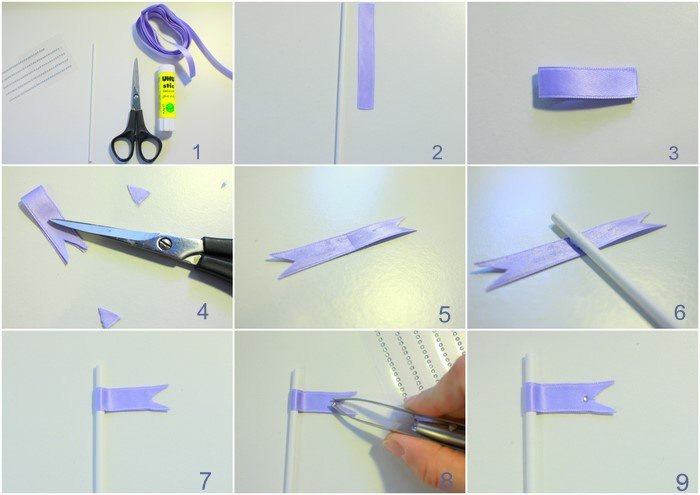
1- Cut ribbon, approximately half the size of the lollipop stick you will be using for your cake pops.
2- Fold the ribbon in half
3- Cut a triangle with your scissors and detach it, as in picture 4 above
4- Open the ribbon and put glue generously in it
5- Place the lollipop stick in the middle of the ribbon flag
6- Fold the flag, leaving the stick in the middle and press both sides against each other for a few seconds so that they are properly glued together
7- With the help of tweezers, take one self-adhesive gem and place it on the flag, as shown in picture 8.
8- Press the gem against the flag for a few seconds so that it is well attached. Picture 9 shows how it will look after it is finished.
And here are all the ones I made, ready for their cake-pops.
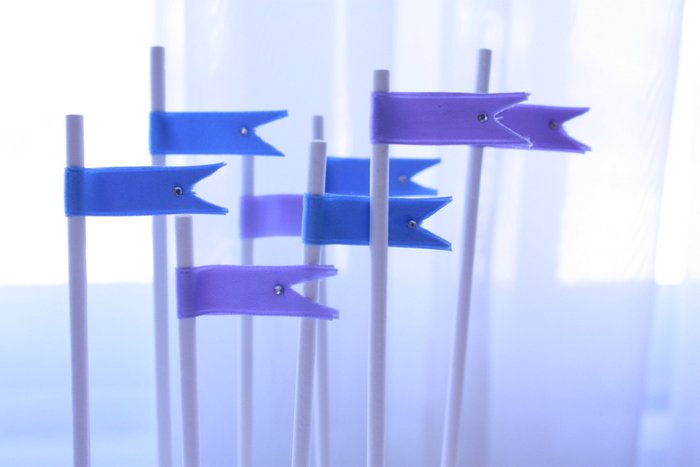
It is almost as if they were saying “We want cake-pops! We want cake-pops!“, isn’t it? 😉
Have you made cake-pops before? Do you have any tips and tricks to share with other readers? If you do, please leave a comment!
Have a wonderful weekend!
*If you want to make cookie pops, you can find recipes, tips and tricks here (in English), and here (in Spanish)
by Marcela M. | Jun 27, 2011 | Blog, cookies, Cooking basics and tutorials, Recipe Box, Recipes, Sweets

Hello dear friends! How was your weekend? Are you ready to start a new week?
A few readers have asked me for the recipe of the meringue cookies I served at my birthday party, so here is all the information and a few tips.
The recipe I used for the cookies is The TomKat Studio‘s Susie’s Forgotten Meringue Recipe. I have been following Kim’s blog for a long time and I bookmarked this recipe the minute I saw it. In Argentina we call them “merenguitos” but the cookies from this recipe are softer and chewier than them. They just melt in your mouth!So if you want to do them, just click on the link above and follow the recipe (and after you do that, take a look and Kim’s beautiful creations, they are amazing!).
Before starting, make sure the bowl and all utensils you will use are very clean. In order to make sure they are spotless I spray a little bit of lemon juice in them and then wipe it out using a paper towel (a trick I learnt from Sweetapolita)
I am adding below a few tips for those who -like me- don’t own a stand mixer, and I hope you will find them useful if that is your case.
As I mentioned above, I do not own a Kitchen Aid or any other stand mixer*, so making some recipes becomes a challenge. What I do own is a Moulinex Masterchef 8000 food processor, which comes with a whisk attachment:
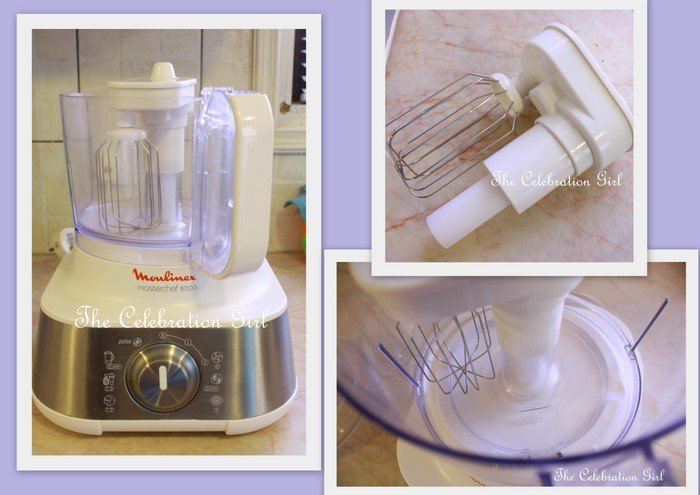
This type of machines have their limitations, and they are generally unable to reach really hard meringue peaks, or they leave a part of the batter unmixed (the one between the bottom of the bowl and the whisk). But they are still very useful (and definitelly better than beating by hand!).
What I will show you is the consistencies I worked with for making these meringue cookies. I am doing this because I know how frustrating it can be to watch pictures of preparations done with stand mixers, not being able to achieve such consistencies and not knowing whether the ones we can actually achieve are enough for the recipe.
The recipe mentions 3 different consistencies:
1) Foamy: When your egg whites look as below, add cream of tartar and salt.

2) Soft peaks: When your egg whites look as below, start adding sugar:

3) Hard peaks: Continue beating until your meringue looks at least as in the picture below.The meringue has to be the harder consistency you can reach in order for the cookies to hold their shape (especially if you want a cute star shape), otherwise they won’t.

This is not the ideal consistency (which is harder) but is all my processor will achieve (after a good 15/20 minutes of beating at maximum speed) and enough to make these cookies. In order to make sure that they do hold their shape, it is a good idea to keep the meringue in the fridge (in a bowl covered with foil) for about 15 minutes, before putting it in the piping bag.
After your meringue is ready, just add colouring and put it into piping bags. For the cookies I made, I used a 2D and a 1M piping tip, for the aqua and lavender cookies, respectively. As you can see from the picture below, the 2D is a closed star tip and the 1M an open star tip. The cookies I piped with the 2D tip held their shape better than the ones I piped with the 1M tip.
Here is how the tips look from above, in case piping tips are classified in a different way where you live:
After you have piped all cookies, simply put them in the oven, following the recipe’s instructions. After they are ready, let them rest in the oven for several hours.
Here is a picture of my aqua cookies the day after I made them:
And this is all! They are cheap, easy to make, delicious to eat and look really pretty at a dessert table! Thank you Susie and Kim for sharing this recipe!
Will you make them?
* Kitchen Aid stand mixers are very expensive outside of the US (560 euros in Cyprus for example)
by Marcela M. | Jun 16, 2011 | Blog, cookies, Cooking basics and tutorials, Recipe Box, Recipes, Sweets, Uncategorized

A few readers have asked me how I decorated the oreos I served for my birthday, so here goes the tutorial.
The truth is that I am not very good at drawing, nor do I own a copy cat projector, so piping elaborate designs becomes a challenge (and for me anything other than a circle falls under “elaborate”). But I really wanted to draw flowers on cookies for my birthday’s dessert table, so I had to find an easy and affordable way to do it.
The idea for these cookies occurred to me during a visit to my local baking supplies store, where I saw these Wilton Fondant Garden Shapes cut outs, and noticed that they were smaller than a normal round cookie. So I bought them and came out with the following super easy method for decorating chocolate dipped oreos (which is probably already used by somebody else too, because it is really, really simple). I did the transfer with royal icing and not with chocolate or candy melts because I must confess that I haven’t yet mastered either, but it could also be used with them too, if you prefer.
With regards to royal icing consistency, I follow Sweet Sugar Belle’s 20 second rule, because it allows me to use only one piping bag per color- as opposed to two (1 for outlining, 1 for flooding). It is also great for achieving the 3D look of the first and last row of cookies. As with most recipes, it is a matter of personal preference, this is just what works for me.
For decorating the oreos as I did you will need:
1- Chocolate dipped oreos
2- fondant cut outs/small cookie cutters of any shape you want
3- Piping bags filled with as many colors of royal icing as you wish to use in your design
4- I used number 2 piping tips, but I believe a number 3 may also work. If you want to outline the cookies with a fine line, use a number 1 tip.
Here is what I did to guide my not-really-skillfull piping:
1) In the picture below you can see the chocolate dipped oreos and the fondant cutters. I used the ones I mentioned above, from Wilton, but you can use any which fits inside the shape of the cookie you want to decorate.

2) I pressed the cutters, firmly but softly, on top of the cookies. The pressure has to be enough so that it will leave a mark, but not that much that it will break the cookie!
Here you can see how the cutter left a shape in the cookie:
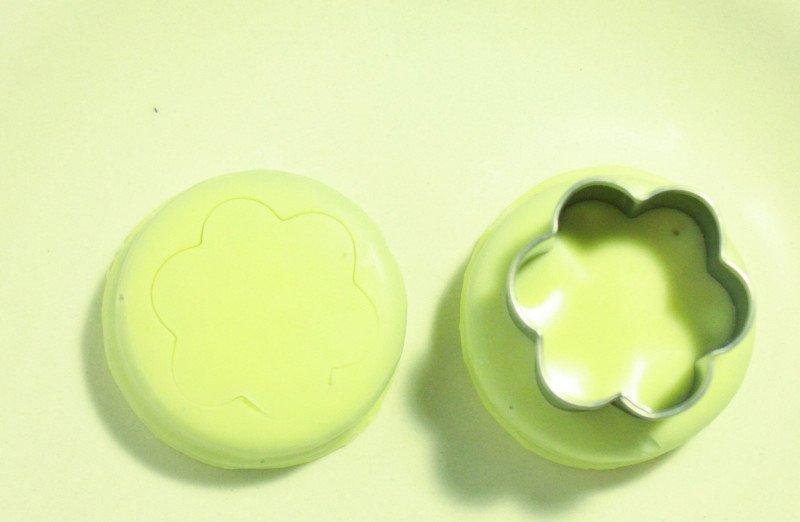
Now the method changes according to how you want to decorate your cookies.
3) a- If you want to decorate them as in the 2nd and 3rd rows, follow the next steps.
a1- Using a piping tip number 2 or 3, pipe around the shape left by the cutter. You may use a toothpick to guide the royal icing into the carving left by the cutter, and to make sure that the shape is respected:
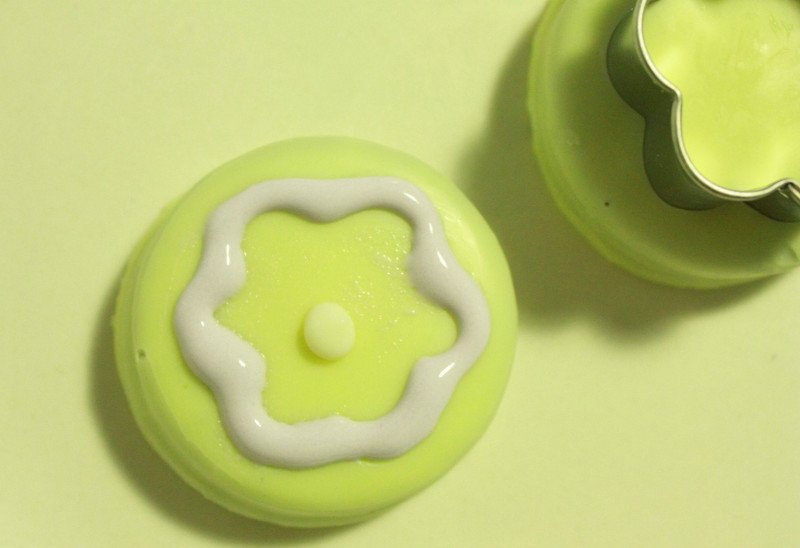
a2- Flood the inside of the cookie immediately. Pipe a dot in the middle of the daisies immediately after flooding. When you are finished they will look like this:

a3- Let dry for at least 2 hours. After that, outline the cookies with the same color.
3) b- If you want to give the decoration a 3D feeling (as the daisies of the 1st and 4th row), do as follows:
b1- Using a piping tip number 2/3, pipe a dot in the center of the daisies (as in the bottom right cookie). Let dry for 30 minutes.

b2- Pipe half of the petals, leaving always a blank one in between , as shown above. Let dry for 30 minutes.
b3- Pipe the remaining petals. Let dry completely.
And that’s all! Easy, isn’t it?
It is very important that you allow the piping to dry for 30 minutes between each step, in order to ensure that the different colors don’t mix. If you don’t, your cookies may end up looking like this:

Here is another picture of the finished cookies.

You can use this method with any shape of cutter, you can use different colors, add shimmer or disco dust, etc. There are so many possibilities and decorating cookies is so much fun!
What is your favourite method for decorating cookies?

































